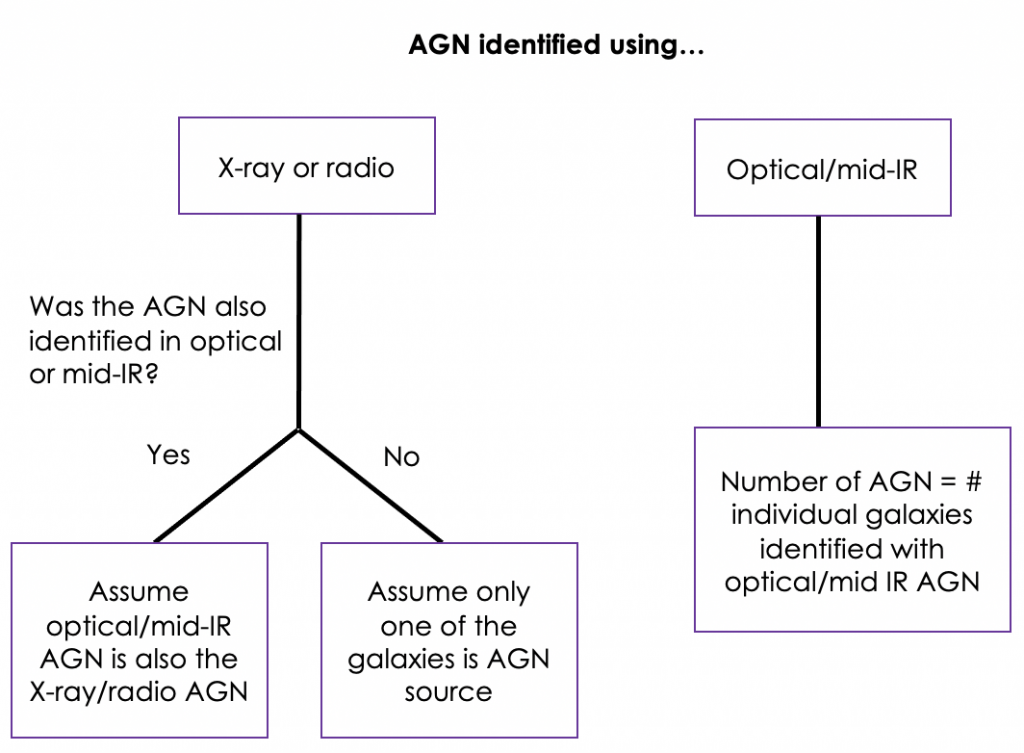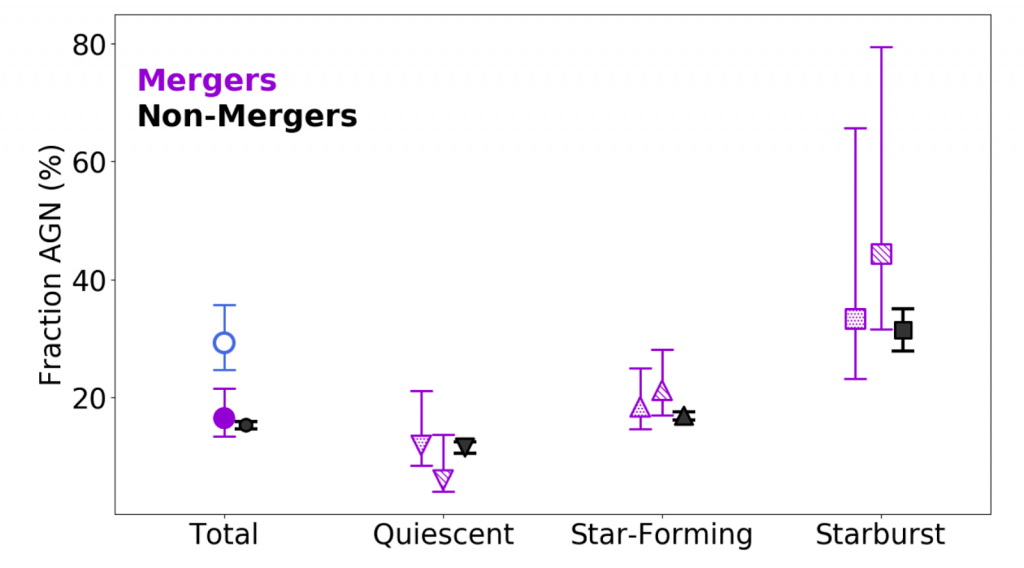Title: Galaxy mergers up to z < 2.5 II: AGN incidence of merging galaxies at separations of 3-15 kpc
Authors: Andrea Silva, Danilo Marchesini, John D. Silverman, Nicholas Martis, Daisuke Iono, Daniel Espada, Rosalind Skelton
First Author’s Institution: National Astronomical Observatory of Japan, National Institutes of Natural Sciences, 2-21-1 Osawa, Mitaka, Tokyo 181-8588, Japan
Status: Accepted for publication in ApJ [closed access]
Double the Fun…and Double the Trouble
Galaxies are extremely complicated systems, with gas, dust, and stars all in interplay with each other through an amalgam of gravity, angular momentum, magnetism, and much more. When two (or more!) galaxies merge with one another, the host galaxy can be significantly altered, including its morphology, metallicity, and other physical properties, casting mergers in a significant role in galaxy evolution. During a merger, gas from the interacting galaxy will fall into the host’s gravitational potential and lose angular momentum, causing it to cascade inwards where it will accrete onto the supermassive black hole (SMBH) at the center. When gas falls into a SMBH accretion disc, it can cause a tremendous release of energy as multi-wavelength radiation, which is then dubbed an Active Galactic Nucleus, or AGN.
This might lead us to logically assume that since AGN are powered by accreting gas, and mergers provide a galaxy with such gas, that merging galaxies should have high AGN activity. That would make sense, right?
Unfortunately, the picture is not so clear. Investigating the connection between AGN activity and galaxy mergers is a tricky business, and different research groups have yielded conflicting results–some find a higher AGN fraction in recently merging galaxies, others find that the majority of AGN are triggered by processes other than merging. In today’s paper, the authors launch straight into the midst of this debacle and explore the role of major mergers in triggering AGN in galaxies at intermediate to high redshifts.
Somewhere over the EM Spectrum
The first step in their investigation is surprisingly difficult–detecting and selecting galaxies to create a sample of merging and non-merging galaxies. Entire papers have been written just about methods to detect mergers, from more simple visual inspection to writing entire neural networks to dig through thousands of images. The authors of this paper specifically used an algorithm that identified bright peaks in images and had a set of selection criteria for which peaks to mark as mergers. They specifically focused on obtaining galaxies undergoing major mergers, meaning that the mass ratio of the two galaxies had to be > 1:4, at redshifts 0.3 z
2.5. They selected high mass (
) galaxies from an optical sample of 5717 galaxies from Hubble survey (3D-HST) catalogs and extracted various properties of each galaxy to separate the true mergers from pesky contaminants.
They then used photometric measurements to identify the redshift of each galaxy, and used colors to separate their sample into quiescent (no star formation activity), un-obscured star forming, and dusty star forming galaxies. This was used to further group galaxy pairs into wet, mixed, and dry mergers, corresponding to both, one, or neither galaxies being quiescent, respectively. In order to actually identify and characterize AGN in galaxies, the authors also cross-matched the sample with X-ray, mid-infrared (mid-IR), and radio data, with each wavelength range having different criteria for determining whether an AGN is present or not.
And the verdict is…*drumroll*
With galaxies meticulously characterized and categorized, the authors could now launch into analysing the data and looking for clues to see whether mergers were actually culprits of increasing AGN activity in galaxies or not. The first metric they investigated was the total AGN fraction in mergers and non-mergers. For non-mergers, the naïve AGN fraction is given by = 15.2
0.6%, where
is the total number of galaxies that host AGN and
is the total number of galaxies that have measurements enabling us to find potential AGN candidates. After correcting for the AGN that were detected by Chandra Observatory, which has varying sensitivity, our corrected AGN fraction comes out to 15.4
0.6, not statistically significant from the uncorrected fraction.
Mergers need the same correction as before, but are even trickier because for AGN identified in X-ray or radio, the authors couldn’t tell which of the two merging galaxies was the emitter of the AGN. They made a few assumptions to correct for this, the logic of which is shown in Figure 1.

After completing the corrections, the authors found that the corrected AGN fraction for mergers was 16.4%, which is very similar to the 15.4
0.6% fraction that non-merging galaxies had, assuming that only one of the galaxies in each pair is the source of the AGN.
Another good indicator of AGN activity is a galaxy’s [OIII] luminosity, so the authors compared the distribution of this luminosity in the merging and non-merging populations, and also found them to be identical at a high level, corroborating their findings that the AGN fraction is not significantly different in merging vs non-merging galaxies. The authors do propose an explanation for this. In general, as cold gas from merger accretes, it triggers turbulence in the galaxy which lights up star formation and feeds its SMBH. At high redshifts like the galaxy sample in this paper, the gas content of galaxies is higher, denser, and more turbulent than at lower redshift. The authors posit that this could be part of the reason why they don’t see any significant effect of merger on AGN fraction in galaxies at these redshifts: the gas is already highly turbulent, and so the merger is ineffective at increasing the turbulence as it might with lower redshift galaxies.
Their second investigation broke down the high-level dichotomy of merger vs non-merger and dug deeper to probe how the AGN fraction differs between both merger and galaxy types. They found that in both mergers and non-mergers, the AGN fraction in star-forming and starburst galaxies is higher than in quiescent galaxies (Figure 2), which makes sense given that they also found that mixed and wet mergers have higher AGN fractions than dry mergers (Figure 3). This could indicate that the presence of a star-forming galaxy in a merging pair could play a role in increasing the likelihood of the merger to yield an AGN, though the difference is not statistically significant enough to make this conclusion definitive. In fact, it makes logical sense given that AGN activity is fueled by cold gas, which is more abundant in star-forming galaxies.


The final relationships they tested were the evolution of AGN fraction over redshift and over galaxy separation. For non-mergers, they learned that the total AGN fraction increases as redshift increases, while for mergers, it increases with redshift once you get to (z1.5) and is pretty consistent at lower redshifts. Since both mergers and non-mergers show approximately the same trend in AGN increasing with redshift, the authors suggest that this supports other studies that propose that mergers are not dominant triggers of AGN. As for how AGN fraction changes with the radius of separation between two merging galaxies, the data showed that there was no significant difference in the fraction as you go to larger separations.
Overall, it may seem that this paper yielded a lot of null results, but they do help us reinforce some expectations we have regarding key players in igniting AGN activity, and papers with such anti-climactic conclusions are still seminal in increasing our understanding of important processes in galaxy evolution. The authors also remind us that new telescopes with better resolution are needed to solve the problem of determining which galaxy is actually host to the AGN (or if both of them are!), so keep an eye out for new results using telescopes like JWST and Lynx!
Astrobite edited by Roan Haggar
Featured image credit: ESO/WFI (Optical); MPIfR/ESO/APEX/A.Weiss et al. (Submillimetre); NASA/CXC/CfA/R.Kraft et al. (X-ray)




